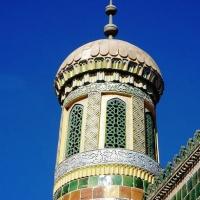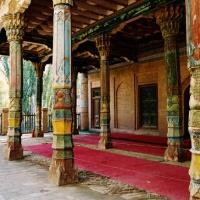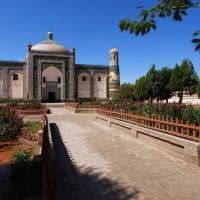 Apakh Hoja Tomb (or Xiangfei Tomb), 5 kms northeast of Kashgar, an important cultural unit protected by the Xinjiang Autonomous Region. As a tomb group of the descendants of an Islamic missionary, it was built around 1640. The legend has it that seventy-two persons in all of five generations of the same family were buried in the tomb.
Apakh Hoja Tomb (or Xiangfei Tomb), 5 kms northeast of Kashgar, an important cultural unit protected by the Xinjiang Autonomous Region. As a tomb group of the descendants of an Islamic missionary, it was built around 1640. The legend has it that seventy-two persons in all of five generations of the same family were buried in the tomb.
The first generation buried here was Yusuf Hoja who was a celebrated Islam missionary. Abakh Khoja, Apak Khoja, or more properly, a great-grandson of the famous Naqshbandi Sufi teacher, Ahmad Kasani (1461 - 1542) (also known as 'the Great Master'), was a religious and political leader in Kashgaria (in modern-day southern Xinjiang). Afaq Khoja was revered as a Sufi teacher in his own right. Among some Uyghur Muslims, he was considered a sayid, who is a relative of the prophet Muhammad.
Afaq Khoja's influence spread far outside of Xinjiang. From 1671-72, he was preaching in Gansu (which then included parts of modern Qinghai province), where his father Muhammad Yusuf had preached before. On that tour, he visited Xining (today's Qinghai province), Lintao, and Hezhou (now Linxia), and was said to convert some Hui and many Salars there to Naqshbandi Sufism.



Accoridng to a legend, Iparhan, granddaughter of Apak Khoja was given to emperor Qianlong as concubine. She was called Xiangfei ( fragrant Imperial Concubine in Chinese) because of the rich delicate fragrance of flower sent forth by her body. After she died for no acclimatization, her remains was escorted back to Kashgar and was buried in the Apak Hoja Tomb.
Thus 'the Xiangfei Tomb' was another name the tomb called. But the textual fact is that Xiangfei was actually buried in the East Tombs of the Qing Dynasty in Zunhua County, Hebei Province after she died. There was only her cenotaph in Kashgar Abakh Hoja Tomb group.
 The tomb is a group of beautiful and magnificent buildings including the Tomb's Hall, the Doctrine Teaching Hall, the Grand mosque,smaal Mosque beside the gate,the gate tower, a pond and archard. The Tomb's Hall, with a domeshaped top of seventeen meters in diameter and covered with green glazed tiles outside, is twenty-six meters high and thirty-nine meters long at the base. The hall is high, spacious and columnless.
The tomb is a group of beautiful and magnificent buildings including the Tomb's Hall, the Doctrine Teaching Hall, the Grand mosque,smaal Mosque beside the gate,the gate tower, a pond and archard. The Tomb's Hall, with a domeshaped top of seventeen meters in diameter and covered with green glazed tiles outside, is twenty-six meters high and thirty-nine meters long at the base. The hall is high, spacious and columnless.
Inside the hall, there is a high terrace on which the tombs are arranged. All the tombs are built of glazed bricks with very beautiful patterns of elegant.Grand mosque is in the west part of the tomb, Ayitijiayi by name, is the place where the Muslim believers conduct service on big days. The Lesser Hall of Prayer and the gate tower are outmost buildings decorated with colorful paintings and elegant brick carvings. Outside the tomb there is a crystal-clear pond lined by tall trees making the place pleasantly quiet and beautiful.
